It's fair to say that Got A Ukulele has featured instruments from all corners of the globe. But perhaps one of the more unusual locations is Nicaragua. And I suppose it's then even more unusual to find myself reviewing a second yet different brand from that country. This is a Baritone ukulele built by NFC Ukuleles.
NFC are a new brand of hand made ukuleles built by Nestor Fuentes Castillo in Masaya, near Managua in Nicaragua. He was trained in building by another Nicaraguan by the name of Carlos Ivan Conto, and also explains that as well as coming from a family of musicians, his grandfather also built guitars. So instruments are kind of in his blood and a couple of years ago he stared making his NFC ukuleles. If you sense a familiarity with this one, it's because a good proportion of (but not all) NFC ukuleles employ the striking native Cocobolo wood in their construction. That is not to say they should be confused with Cocobolo brand ukuleles who are also from Nicaragua - they are not the same people. Just the same wood!
And this one is made from all solid Cocobolo in the body and several other parts too. It's a double bout baritone shape with an attractive curved base and sloping shoulders that adds to the character. It's a stunningly striking wood with deep reds, browns, oranges swirling against the paler, creamy coloured sapwood. It's certainly a head turner. It's two pieces each for the top, back and sides, with the sides employing plainer pieces of cocobolo. It's the top and back though which are the main event. I will say though, as I have seen with several instruments made from this wood, the bookmatching is not done in a perfect mirror. So here you get more of the sapwood on one side when looking at the top and the back. Some instruments made from this, including those from the Cocobolo brand have not really been bookmatched at all, so this one is better in that regard, yet.. still not perfect. It sets my OCD alarm off, but still.. many won't mind it. To be fair, it may actually be a feature of the huge grain variance that runs through a piece of cocobolo. Still, I have to mention it. You will also notice that the video shows the ukulele off to be a touch darker, but that is in artificial light. The pictures here are taken in full sunlight and the wood tends to really glow then! It's quite stunning.
The bridge is made of cocobolo wood and uses cocobolo bridge pins to hold the strings. The saddle is made of bone and curved on the top to match the radius on the fingerboard. One thing that troubled me about the bridge when I first took it out of the packaging is that the plate is not attached to the top of the body very straight. Things like that immediately ring alarm bells as if a bridge is in the wrong place, the instrument won't intonate correctly. I then noticed the saddle is on an angle too and the odd angle to the bridge corrects it.... I think.. Sure enough, out with the tape measure and the scale length on each string actually seems to be correct.. Curious! I wonder whether this has been done deliberately? Either way, it's another OCD alarm trigger for me, although maybe it's more a mark of the arts and crafts / handmade nature of this one. If I have one other gripe here, it's that I think the string spacing at the bridge could have been made a bit wider. In fact the strings don't really fan out at all as you move up the neck. That doesn't make it unplayable, but I do know many people prefer more spacing at the dusty end. This is more of a spanish guitar technique that don't really fan out either.
The body is then finished in a nicely done gloss all over (including the neck and headstock). As a gloss done in a small workshop by one man I must say it is deep and glossy and works like a mirror (as the pictures in this review, reflecting back my fence panels will attest!). It's a touch over done in places as you can see around the end of the fingerboard, but still - if you buy a hand made uke you are not going to get a factory production line finish. Either way, I still love how well it reflects and it will certainly protect the instrument.
Inside is very tidy too with the use of Nicaraguan Cedar for the notched linings and braces. The top uses a mix of lateral bracing (drilled with holes in Kanile'a style) just below the sound hole, then north to south braces from there down to the base. Also pleasing to note is the use of a traditional Spanish Heel to connect the neck to the body. This technique actually sees the body built around the neck itself, rather than the neck just being glued and screwed to the soundbox. They are really robust and considered by the great Spanish guitar makers to be the only way to build. Nice.
The neck is made from carved Nicaraguan Cedar, witha joint at the cocobolo capped heel and a well hidden one in the headstock. It's not overly rounded and very comfortable to hold, ending with a near 40mm nut width and almost 30mm from D to E.
Topping this is a deep red swirly grained cocobolo fingerboard in very nice condition. There's a few hand made tooling marks on it here and there, but I always find those to me an interesting mark of a hand made instrument. We have an intriguing 12 frets to the body and only 15 in total. That's unusual for a baritone, though if it works as an instrument it's fine by me. They are more normally joined at the 14th though, yet I have reviewed others joined at the 13th. As I say above, the fingerboard has a very noticeable radius curve to the top (a 7.25 inch radius in fact) for comfortable playing. It's a much tighter radius than I have played before and a bit over curved for me if I am honest. The edges are not bound, but the frets are dressed tidily down both sides. One glaring omission though are fret markers. There are none, either outward facing OR on the side. I couldn't live with that and would have to specify at least something. I suppose it's the beauty of working with a hand made builder though, in that you could specify them. I find it odd that a review model would arrive without them though as I am sure to mention it and i've seen other examples of his that have them!
Beyond the bone nut is a pleasingly simple flat topped headstock that is both faced on the front with cocobolo, but on the back too. The addition of these plates and the gloss makes for a really attractive part of this instrument.
Tuning is via Grover 4 type copy friction pegs with black buttons and it comes strung with D'Addario Nyltech strings, with a wound D and G designed for high D tuning. I'm not a fan of wound strings, but I understand with a baritone that the only alternative are fat chubby strings which I don't care much for either! And like any hand made luthier instrument, the price will depend on what you specify. Nestor tells me his ukuleles start at $450, but something like this baritone will come in at $650. Interestingly, his prices include shipping to anywhere in the world, so the core ukulele cost is a bit less than those listed. Hand made, glossed instrument from a wood like this.. Seems like a fair price to me and on a par with the other cocobolo brand from the same country!
Let's get to know it a bit better. The build here is a mix of positives, some other annoyances and some points which, to be fair, are expected with something hand made. The build is good and well done all over with no gaps, filler or seams showing and I do like that gloss. The slightly mis-matched bookmatching, angled bridge plate and lack of position dots annoy me though and would irritate - but I suppose you could specify these. And, are these life and death? It's not a light instrument either, though I think that is more a function of cocobolo wood rather than being over built. It's nicely balanced at the 12th though. I will say from the off that I don't like the wound strings on the fingers either and think they would do better with more tension, but these are easily changed so don't affect the review.
To play it, the volume is terrific as is the sustain. I will give it less kudos on sustain as this is something large scales and bodies do more naturally anyway, but there is not getting away from the good volume projection here. It's loud as you like! And that hefty feel to the body is clearly not a sign of overbuilding as the projection is not strangled. It's a lively thing!
Tone wise I found it quite surprising. It's a clear tone that works well with the sustain and is pleasant on the ears, but is not as bright as I would like. Sure, it's in a lower tuning than the other scales, but I found the tone to be much darker than I had expected. It sounds almost guitar like in tone, which I suppose is also no surprise because it's in the same key. It's a woody, earthy tone and of course that is something many people like, so that is not to say that it's an unlikeable tone at all, just not what I expected particularly when strummed. I'd like a bit more shimmer and brightness in this department. On the more positive side though, coupled with the great volume and sustain this makes for a really pleasant finger picking instrument. Melody runs ring and ring, particularly up the 1st and 2nd strings, and it doesn't taper off up the neck. It's growing on me, if mixed.
Playability for me was also a little mixed. There is something pleasing about the heftiness of the body build that is nice to cradle and play, but I found the radius on the fingerboard a little too severe for my hands and found myself mis-fretting at times. If I was ordering, I'd certainly be asking for a shallower radius myself, together with a wider bridge spacing.
But then these are quirks, like the quirks in the looks. But putting all the parts together I found that I really quite like it overall as it's clearly a decent instrument underneath. I think I'd personally be going for a smaller scale myself, but for baritone lovers I am certain they would have a great deal of fun with this one. And there is no getting away from those head turning looks!
Well worth a look if you like something different and supporting independent builders.
https://www.facebook.com/NFC-ukuleles-1387349118036550/
UKULELE SPECS ROUNDUP
Model: NFC Baritone
Body: Solid Cocobolo
Bridge: Cocobolo
Saddle: Bone
Bracing and linings: Nicaraguan cedar
Neck: Nicaraguan cedar
Fingerboard: Cocobolo
Frets: 15, 12 to the body
Nut: Bone
Nut width: 40mm (30mm D to E)
Tuners: Grover copy friction pegs
Strings: D'Addario Nyltech
Price: $650 in this spec
UKULELE PROS
Head turning looks
Great deep gloss
Nice traditional neck joint
Terrific volume
Great sustain
UKULELE CONS
Some OCD alarms in the looks department
No fret markers at all
Radius is too severe for my tastes
Tone is darker than I would like
UKULELE SCORES
Looks - 9 out of 10
Fit and finish - 8 out of 10
Sound - 8 out of 10
Value for money - 9 out of 10
OVERALL UKULELE SCORE - 8.5 out of 10
UKULELE VIDEO REVIEW
© Barry Maz
GOT A UKULELE IS NOT BRAND SPONSORED - DONATIONS KEEP THE SITE GOING!

THANKS!

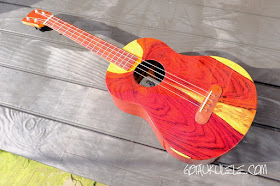

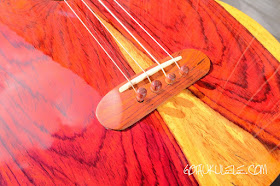
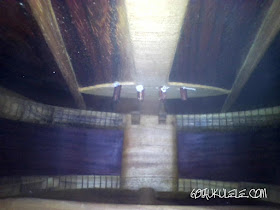

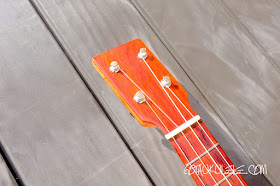
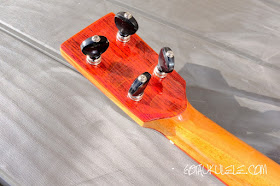

Very nice. I have a tenor uke made by Luis Pilarte in Masaya and it does not have fret markers either. I lived in Nicaragua in the 1980s and I looked back at my old photos of people playing guitars. Neither seemed to have fret markers either. So that might be the Nicaragua luthier style. Cocobolo Ukulele is managed by a Canadian so he might have specified fret markers.
ReplyDeleteCurious as to your opinion of your Luis Pilate?
DeleteGreetings from Nicaragua I like your comment.
ReplyDeleteGreetings from Nicaragua I like your comment.
ReplyDeleteWow, it makes me want another Nicaraguan ukulele. My Cocobolo Ukulele is far from perfect, but I don't have OCD, so we get along fine.
ReplyDeleteI quite fancy a lot of radius, and don't mind a narrow nut.
I think this would make a fine addition to my ohana, if I were to begin playing a baritone.
Thanks for the review, I'll watch the video when the internet is less busy.